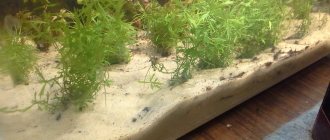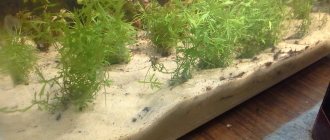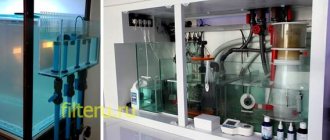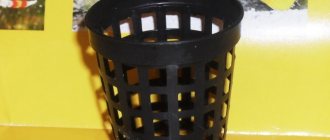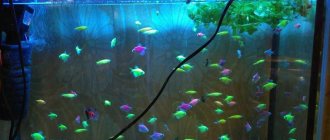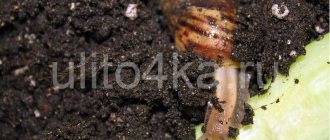In every aquarium with fish and living plants, biological waste accumulates in the soil. These are leftover food, dead leaves and fish excrement. All this turns into silt over time. Of course, a certain amount of sludge must be in the soil, because it is the nutrient medium for aquarium plants. But too much sludge is bad for the aquarium and its inhabitants. Some fish dig into the ground in search of food, picking up dirt from the bottom, which settles on decorations and plants, which leads to the appearance of black beard or flip flops on plants. In addition, a large amount of organic matter in the water increases nitrites and ammonium, and the fish begin to itch and get sick.
To remove dirt from the aquarium, siphon the soil once a week while simultaneously changing the water. When siphoning, fish waste products, food residues and rotting plant leaves are removed from the soil, and nitrites are removed. And loosening the soil improves gas exchange at the roots of aquarium plants. How to properly siphon the soil so that your home pond remains clean?
Why is soil cleaning necessary?
Remains of food, fish excrement, particles of dead stems and leaves of plants fall to the bottom. Putrefactive processes spread throughout the reservoir. The substrate layer gradually cakes, turns into silt, and zones appear where oxygen does not flow. Beneficial bacteria that create a healthy biobalance of the reservoir are replaced by pathogenic ones.
When the level of organic waste reaches a dangerous level and begins to exceed the norm, it is necessary to clean the soil in the aquarium. This is very important for the life of fish. Accumulated toxins can simply poison them.
On a note! More often than usual, it is necessary to siphon the bottom of the aquarium without soil. Biological waste in it is not processed naturally, quickly accumulates and pollutes the tank.
How should everything work ideally?
In a natural (or as close to natural) ecosystem there are always many participants. Fish excrement and the remains of their meals are eaten by bottom invertebrates - snails, shrimp, protozoa and bacteria - and processed into small fractions.
Plants with a powerful root system use this organic matter for their nutrition, so almost nothing unnecessary remains at the bottom.
What if we have a large container with large predatory cichlids? There is no talk of any shrimp there, and it is problematic to plant plants, and all the waste accumulates at the bottom in an unprocessed form. This is where the need for a siphon arises.
The benefits and harms of soil siphoning
The easiest way to clean dirt at the bottom of an aquarium is to use a siphon. The benefits are obvious:
- soil acidification is prevented;
- excess organic matter that pollutes water is removed;
- removes unpleasant odors that are toxins for fish (methane and hydrogen sulfide);
- In densely populated water bodies, biobalance is regulated.
If a siphon is performed without the necessary indications, it causes harm:
- colonies of beneficial microorganisms are disrupted, natural biofiltration deteriorates;
- nutrients necessary for plant development are removed from the soil;
- there is a risk of damage to the root system of the flora.
To clean the soil in an aquarium without negative consequences, you need to take into account environmental conditions, the number of aquatic inhabitants and the condition of the plants. In each specific case, a balanced decision is made about the need to clean the bottom with a siphon.
How is cleaning done?
You should use the siphon a few weeks after starting the aquarium, not earlier. Firstly, there will be no point in the procedure, since organic matter and food residues have not yet had time to accumulate. Secondly, the inhabitants of the aquarium are just getting accustomed to their new place, therefore, it is not advisable to disturb them.
The cleaning process, in addition to removing excess organic matter settled on the ground, involves removing part of the water. In some cases, it is filtered and returned back, in others it is simpler and topped up with clean water to the desired level.
Cleaning procedure:
- Prepare a siphon and a container for water (a regular bucket will do).
- Fill the siphon tube with water and immerse it in the aquarium. The free end must be lowered below the bottom level, otherwise the water will not flow by gravity (if an electric siphon model is used, this condition is not necessary).
- It is recommended to conditionally divide the bottom area into squares in advance so that cleaning is as thorough as possible. This especially applies to large aquariums.
- Using a tube, lightly stir up the soil, raising the turbidity. It is recommended to immerse it to the very bottom (to the glass) in order to siphon the entire layer of backfill and remove organic matter with maximum efficiency.
- Heavier soil particles will settle to the bottom, and organic matter and fine suspension will be picked up by the water flow and discharged into the prepared container.
- The process is controlled by monitoring the state of the flow. As soon as the water in the tube has become clear, the procedure is transferred to the next section of the bottom (or stopped altogether).
The more powerful the siphon, the larger the tube diameter required. If the water leaves too intensively, the soil itself may be sucked in, which is undesirable. It is necessary to organize the process so that only organic matter and suspended matter are removed, and the backfill layer remains at the bottom.
Types of siphons
Manufacturers produce electric and mechanical siphons, which differ in a number of characteristics.
Electric siphon.
Mechanical siphon.
Before buying a device, you need to know for which aquarium it will be used; its size depends on this:
- standard, for regular and large tanks;
- reduced, for nano aquariums.
Battery-powered siphons are designed for cleaning reservoirs in which the water level does not exceed 0.5 m. Electric devices can be used to siphon soil in an aquarium in one of the following ways:
- suck up dirty liquid and send it to the sewer or into a special container;
- pass the water through the filter and return it back to the aquarium, already cleaned, so there is no need to change the water in large volumes.
The thicker the cross-section of the tube, the greater the pressure. There are differences in cleaning funnel configurations:
- rounded shape, with one right angle, for standard cleaning;
- with a tapered tube tip for hard-to-reach areas.
If a funnel with a tube is equipped with a strainer, the device will allow only the smallest waste to pass through and leave large fractions in place. To easily monitor the cleaning process, the hose must be transparent.
How does a siphon for an aquarium work?
A mud pump, soil cleaner or siphon for an aquarium is a device consisting of several elements:
- transparent tube or funnel;
- flexible hose (rubber or PVC);
- pump with electrical or mechanical drive.
The general principle of operation is the same in any case - a transparent funnel is placed on the ground, water along with contaminants enters it and through a flexible hose enters a special trap (this is a small reservoir located immediately after the pump).
The water either enters a separate container, from which, after filtration, it returns to the aquarium, or it immediately goes back, passed through a mesh filter.
Mechanically driven siphons are cheaper, but the cleaning process with them is more labor-intensive; you have to manually operate the pump and filter the removed water before returning it to the aquarium. Siphons with an electric motor are more convenient to use, but somewhat more expensive.
1 - Mechanical siphon 2- Siphon with electric motor
As a rule, mechanical devices are preferred by owners of relatively small aquariums, while electric ones are purchased for large containers that require lengthy and thorough processing. At the same time, there is a limitation on the height of the walls - if they are higher than 50 cm, water can be poured into the battery compartment of the siphon.
In addition, you need to pay attention to the height of the glass (funnel). It is recommended to choose models with a suction part height of at least 20 cm. Then large soil particles will settle to the bottom without entering the hose and container with water or filtrate. This is an important point, since otherwise the amount of soil will decrease with each cleaning and require regular replenishment.
You should purchase siphons with a transparent tube (funnel) to control the cleaning process and stop it in time.
How to siphon soil correctly
When biobalance has been established in the reservoir, regular soil siphoning is carried out in parallel with the planned water change:
- In large tanks, soil is cleaned using a siphon twice a month.
- With a high density of fish population in the reservoir, cleaning is done once every 7-10 days.
- The bottom of jigging tanks for fry without soil is siphoned daily.
- If the roots of the plants have turned brown and are rotting, it means that the soil needs to be cleaned more often.
The siphon consists of a plastic flask, a flexible hose and a rubber bulb for sucking water. If there is no pear, a bowl for draining the liquid is placed below the aquarium so that the water flows by gravity according to the law of physics. It is necessary to monitor the transparency of the intake water. When it becomes transparent, move to another area.
A few rules to follow when cleaning:
- The funnel is not deepened into the soil layer, but is slowly moved along the surface. Dirt and debris are drawn in on their own.
- You need to siphon especially carefully in corners, crevices, places under snags and decorative elements, near the front wall.
- There is no need to clean near the root system of plants. Organic matter is needed for growth. If you deprive plants of a nutrient medium, they will stop developing.
- During cleaning, do not drain water more than 30%.
You can perform the procedure yourself, but it is better with an assistant who will ensure that the water flows into the container. It is not necessary to add additional stones and sand after cleaning. They do this when there is a desire to change the bottom topography or improve the panorama of the aquarium using stones of a different color.
Types of mud cleaners
Remove excess organic matter using an aquarium siphon.
Plastic flask
Plastic flask with a hose for soil siphoning
The simplest device is a plastic flask (glass) with a soft hose attached to it.
Many people make this design on their own, using part of a plastic bottle, tape and a polypropylene hose. Water is pumped according to the principle of overflowing vessels. But to do this, she needs to help and draw air from the tube until the liquid begins to move. If you are afraid of swallowing water, you can first fill the siphon with tap water, then lower the flask into the aquarium with the hole facing up while holding the other end of the hose with your fingers. When this end is released into the drain container, water will flow out of the aquarium. To prevent soil granules from flying into the hose during operation, it is squeezed by hand and then they fall back to their original place.
Plastic funnel attachment
Another type of mud cleaner is a wide plastic funnel attachment, a hose and a hand pump (bulb) for pumping up water.
When not to siphon
There is no need to clean the aquarium with a siphon when it is completely planted, there are a lot of shrimp, small snails and fry. Plant roots penetrate the soil and act as a natural aerator, releasing oxygen. Therefore, souring does not occur. The situation is different when the plants have unbranched, weak roots, and the soil lies in a thick layer.
You should definitely not siphon the soil in the following cases:
- the aquarium was launched less than two weeks ago;
- the colony of nitrifying microorganisms has not yet grown;
- Only aquatic plants are grown in the tank, and the siphon actively washes out the nutrient substrate.
There is a sure way to check the condition of the soil with plants: move it with a stick. If bubbles appear and cloudiness rises, it’s time to siphon. This means that the decay products of aquatic life rise up and become a source of pathogenic bacteria.
What is a siphon?
Siphoning is cleaning the soil of an aquarium using a special device (a hose with a cylinder or funnel at the end) by sucking out small particles - detritus - from the surface and from the thickness of the soil.
The end of the siphon is placed into the soil at the required depth, the flow of sucked water picks up everything that is in the cylinder or funnel, but heavy gravel particles settle back, and light detritus leaves through the hose.
After this, the siphon funnel is moved and cleaning of another area begins. Thus, after the siphon, ideally there remains clean soil, without silt.
Alternative methods for cleaning soil
If necessary, you can clean the soil without a siphon. They do this as follows:
- The fish are transplanted into a separate container.
- The substrate is taken out of the aquarium into a bucket.
- Pour water into the bucket under pressure, stirring the soil periodically.
- Drain the cloudy water several times until it becomes clear.
- If the substrate is large, you can use a colander instead of a bucket. Soil washing will be faster and more efficient.
Do not use chemical cleaning agents. It is impossible to wash them without leaving a trace. If necessary, pebbles can be disinfected by boiling for 20 minutes. This way you can clean the bottom of the aquarium without draining the water.
Making a siphon with your own hands
The price of a regular mechanical siphon is in the range of 500-700 rubles. This is quite affordable for aquarists, but many prefer to make siphons themselves, not wanting to waste time searching or waiting for the device to be delivered from online stores.
For a homemade siphon you will need:
An empty plastic bottle (0.5 l) with a lid, preferably transparent.
Shoe knife.
A piece of hard plastic hose 50-60 cm long.
1.5-2 m of flexible hose with a diameter of 10 mm.
To make a siphon, you must perform the following steps:
- The plastic bottle is cut so that a funnel of the required diameter is formed. For more active water suction, the edges can be made jagged.
- A hole is made in the lid for connection to a rigid tube. An adapter is installed on the free end to connect a flexible hose.
- All connections are sealed with electrical tape (you can use silicone sealant).
At this point, the production of a simple siphon can be considered complete.
What to do to clean the soil less often
An aquarist does not always have time to clean his home pond. You won’t have to siphon the bottom often if you follow the following recommendations:
- Correctly calculate the number of fish for certain dimensions of a reservoir. If there is a lot of organic matter, the aquarium is probably overcrowded.
- Plant plants with a branched root system that need more nutrients. They will process fish waste products.
- Reduce the layer to 3 cm so that plant roots can penetrate deep without hindrance.
- Organize the feeding diet of aquatic inhabitants. Do not overfeed, make sure that the fish eat the food completely, as uneaten food greatly pollutes the environment.
- Introduce aquarium snails. They are not just beautiful. Many types of snails actively eat food debris, rotting plant stems and other debris, and clean the tank walls and decorative elements. Thus, they help reduce the level of toxins in the aquatic environment.
There is a rule: one-dimensional particles (no matter whether large or small) do not cake and are less susceptible to souring. You will be able to clean the bottom of the aquarium much less often if you follow most of these recommendations.
Mode and principles of siphon cleaning
The number of cleanings and the interval between them is purely individual for each type of aquarium. This mode depends on the following indicators:
- population density;
- types of fish;
- amount of feed and frequency of feedings per day;
- presence of decorations;
- density of planting with plants, their types, condition;
- height of the embankment, type of soil.
Different aquariums have their own siphon specifications. In large containers with large fish and no plants, where powerful filters take on the entire load, the soil is cleaned regularly every two weeks and completely clean. With more frequent cleaning, the population of microorganisms does not have time to recover; less frequent cleaning can lead to poisoning. In a densely populated aquarium, the interval between cleanings is reduced to 1-1.5 weeks.
In nurseries where juveniles are kept separately, as a rule, the soil is not covered, but the bottom is siphoned daily to remove food residues and excrement.
Carefully carry out cleaning in tanks with a low population density and partially planted with vegetation with a root feeding system. Siphon only open areas (with special care near the front glass), under snags and between decorations. In the area where plants are planted, the siphon is not deepened so as not to harm the roots. The procedure is carried out once every six months or even once a year.
You can determine that it is time to siphon the soil by a number of signs.
If you stir the soil with a thin stick and a large amount of air bubbles begin to emerge from it and cloudiness rises, then it’s time to siphon the substrate.
Another indicator is the condition of the plant roots. If they turn brown or begin to rot, which becomes clear when weeding, you should clean them up.


